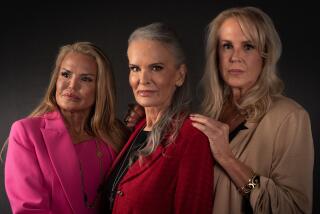Whom Do You Serve First? : Foundations want to sponsor multicultural programming for theaters, but audiences are not all ready to buy in. A look at how the Mark Taper Forum is coping.
Gordon Davidson sinks into a couch in his office beneath walls filled with posters for plays he has recently produced at the Music Center’s Mark Taper Forum: “Angels in America,” “Twilight: Los Angeles, 1992,” “Black Elk Speaks.” Nearby, artworks from earlier shows bear witness to his three decades in Los Angeles theater: “Terra Nova,” “Children of a Lesser God,” “Zoot Suit.”
The array of subcultures and social issues that these dramas take as their subjects--gay life, urban unrest, the Native American experience and more--suggests that this is a display that could only belong to a theater man of a certain stripe.
“I’m a liberal,” the Taper artistic director says in a voice that still smacks of New York, even after all these years. “I believe in affirmative action. I believe in welfare. I’m not trying to be politically correct. I happen to believe in it.”
Those beliefs have come in handy lately--especially as the Taper has found itself in the midst of the continuing national experiment known as multiculturalism that took hold beginning in the late 1980s. As the flagship theater in increasingly racially charged Los Angeles, the Taper provides a revealing case study of some of the major audience-building challenges facing arts institutions today.
While the Taper has long averaged about one work a season addressing the interests of minority constituencies, Davidson and his staff have greatly increased that number in recent years. In large part, this has been in response to two factors: the folding in 1991 of the Los Angeles Theatre Center company, long known for its political work, and a push from some granting organizations toward greater diversity.
Faced with a diminishing subscription base that may be attributed, at least in part, to the new programming, Davidson’s report from the front is decidedly mixed.
“We have to acknowledge that these changes (in the type of material being staged, as well as in audience demographics) mean giving something up, but also, hopefully, gaining something,” he says. “What you’re gaining is a larger view of what mankind and this city consist of, and that means sharing the seats with other people. It’s not the most popular theater in town. I only hope that we’re the most engaged in town.”
It’s a tough battle, because the national climate has already begun to turn away from affirmative action. And reflecting that, and many other factors, in the last couple of years, the majority of the Taper’s ethnic-oriented plays have fared poorly with both audiences and critics. Still, Davidson says he plans to stay the course--and arguably has to, given the current priorities of the grant-giving foundations the Taper relies upon.
THE INSTITUTION: THE MARK TAPER FORUM
Davidson was appointed found ing director of the Taper in 1967, about the same time that many of L.A.’s major cultural institutions came into being. From the start, he wanted his theater to be politically charged, and indeed the Taper first made its mark with topical docudramas.
Davidson’s vision--supported by both staff and artists--has always been vintage liberal.
“ ‘Zoot Suit’ was the most emphatic early statement that we made,” he says of Luis Valdez’s 1978 drama. “It was a play that was designed not only to speak to the regular audience but to embrace the audience from which it came culturally.”
The pachuco-era play, inspired by a historical incident, was one of the Taper’s biggest hits ever.
“It worked like gangbusters in that people who had never come to the theater came,” Davidson says. “We were green at it, but we were aggressive. There was an artistic impulse and a civic and cultural communal impulse.”
Other notable early successes also focused on topical issues: “In the Matter of J. Robert Oppenheimer,” produced in 1968, is the story of the physicist who pioneered the development of the atomic bomb. “The Trial of the Catonsville Nine,” seen at the Taper in 1971, portrayed a courtroom drama about a Vietnam War protest.
Indeed, Davidson’s idea of cultural diversity has never been limited to race.
“We repeated (the “Zoot Suit” success) in a different way when we did ‘Children of a Lesser God’ (with hearing-impaired characters),” he says. “I don’t think (this issue is) all about color, though it’s clearly predominantly about color. The earliest attempts at diversity had to do with women.”
But choices in plays are not all that has made the Taper an experiment in multiculturalism: Davidson has also been a longtime proponent of non-traditional casting--the use of non-white actors in traditionally “white” roles in classical works--as made popular by Joseph Papp’s New York Shakespeare Festival.
“I had Lou Gossett playing (Chekhov’s) Vershinin,” Davidson says. “I didn’t think that was such a big deal, but the audience did.”
It is true that since the 1970s, the Taper has been consistent, if limited, in presenting culturally diverse works. But although the 1980s brought increased attention to multicultural issues at the Taper, most of those works were not produced on the mainstage. What’s more, the Taper actually lagged behind other major Southern California theaters in acquiring the accouterments of the trend: on-site ethnic-based development laboratories, play-reading series and diverse board and staff representation.
In fact, San Diego’s Old Globe Theatre and Costa Mesa’s South Coast Repertory Theatre, for instance, were quicker to appoint staff members specifically to focus on issues of multiculturalism. The Globe’s multicultural associate and literary manager, Raul Moncada, has directed the theater’s Teatro Meta since 1986. Similarly, literary associate Jose Cruz Gonzales has been at South Coast Rep since 1985. (The Taper had no such staff members until 1992.)
And among L.A. institutions, the Taper has not traditionally been seen as a bastion for multicultural programming. Until the demise of the repertory company of the Los Angeles Theatre Center, that company, not the Taper, was the local hub for ethnic and gender-based labs and productions during the late 1980s.
When the LATC resident company folded in 1991, though, the Taper began to take on the former’s mission, albeit on a more limited basis. LATC’s Latino Lab and its director, Jose Luis Valenzuela, took the opportunity to move from LATC to the Taper, as did a number of other artists.
GRANTSMANSHIP: LILA WALLACE-READERS’ DIGEST FUND
During the past few years, Davidson’s increased move toward diversity has been encouraged not only by the Zeitgeist but also by grants. Most foundations tend to give money with strings attached, which, in turn, affect what audiences end up seeing onstage.
For the Taper, the directive has been for more Latino-oriented works.
“The biggest change in the past two years is the Latino Theatre Initiative, which is a project that we have embarked on, stimulated in part by a grant,” Davidson says.
The Latino Theatre Initiative is an umbrella program at the Taper encompassing all efforts to increase Latino audiences. It is funded by a grant of $1.47 million, awarded in May, 1993, to be paid over four years by the Lila Wallace-Readers’ Digest Fund, the largest private funder of the arts in the United States.
The Lila Wallace money was matched in the same year by a three-year $800,000 grant for the same project from the National Endowment for the Arts. Together these funds are the Taper’s largest non-Music Center grant ever.
The Taper was not targeting Latino audiences alone when it first made its application to the Wallace fund. It was turned down for grants by the fund in 1991 and 1992 because, says a spokesman at the foundation, the Taper’s goal of simultaneously increasing Latino, African American and Asian American audiences was considered too broad.
“We applied for a grant that would address on a more broad base the question of diversity, not only Latinos,” Davidson says. “They didn’t want to give a grant like that. For what our overall objectives are, it would have fit better.”
Yet compromise was well worth the Taper’s while.
“It was the co-juncture of our own concerns and the stimulus of the grant,” Davidson says.
The Taper took what it could get: “The objective is to try and raise subscriber base among Latinos from about 2% to 10% over a four-year period and for specifically Latino programming to reach 40% single-ticket sale attendance,” says Robert J. Schlosser, the Taper’s director of audience development.
One way to develop audiences is, of course, through programming. This season, the Taper has produced mainstage and extra events designed to bring in new people. The events also aimed at making the theater appear more populist.
The kickoff LTI event, in October, 1993, featured two days of activities, including a procession for El Dia de los Muertos (The Day of the Dead), an evening program and a Latino Lab benefit.
Since then, the LTI has also paid for:
* Commissions to Latino writers at the rate of three or four a year.
* The promotion of the Latino Lab’s Valenzuela from part-time to full-time staff, as the first head of the LTI (he later left, but the grants have also paid the salaries of his successors as well as a program administrator).
* The hiring of Xavier Sibaja to coordinate Latino audience development.
* A marketing study through an audience survey handed out during the run of “Bandido!”
The first mainstage production using LTI funds was Luis Valdez’s “Bandido!” last June. (“Carpa Clash,” a Latino show staged in December, 1993, was in the works before the LTI was finalized.)
“Bandido!” did well financially, according to the LTI marketing survey, grossing more at the box office than any other mainstage production this season to date. (Forty-five percent of “Bandido!” single-ticket buyers were Latino, exceeding the grant goal of 40% in this area, although there are no figures on how many of these one-timers ever returned to the Taper.)
Despite box-office success, there has been internal strain.
In the wake of “Bandido!” Valenzuela resigned from the Taper, citing artistic frustrations, and took the Latino Lab with him to Plaza de la Raza, an East L.A. venue with a 240-seat theater. Valenzuela complained when he left that it would have taken him at least two years to get another Latino Lab work on the Taper mainstage, and he preferred a setting where he could personally produce more work.
(In December, the Taper appointed as his successors a joint directorship of performance artist-playwright Luis Alfaro and actress-writer Diane Rodriguez.)
The second LTI show was Eduardo Machado’s multi-part Cuban American epic “Floating Islands” in October. This time, attendance wasn’t as good as it had been for “Bandido!” And while an audience survey like the one taken at “Bandido!” was not done, the response from the targeted Cuban American community--which numbers about 50,000 in Los Angeles County--was clearly mixed.
THE ART AND THE ARTISTS
New works by living artists are the mainstay of the Taper, but that means Davidson must mediate between the artists’ and the Taper’s needs. These can, at times, be at odds.
The culturally specific plays that some playwrights and directors want to write and stage, for instance, are not always the kind that appeal to audiences and critics. Moreover, while many artists may agree with Davidson’s multicultural intentions, they don’t necessarily agree with his methods.
For all these considerations, though, Davidson still seems particularly energized when talk turns to the subject of artists and their work.
“First and foremost, my impulses come from wanting to work with artists of different colors to better represent the voices that are here in this city,” he says. “It isn’t essentially an audience-driven thing for me.”
Davidson and the Taper’s record is not the same for all ethnic groups. The Taper has produced far more African American-themed work than either Asian American (only “Sansei” in 1988-89 and “The Wash” in 1990-91 to date) or Native American (only the recent “Black Elk Speaks”).
Women have also suffered. In recent years, while Davidson has been paying more attention to race, he has all but neglected plays by women.
Since the beginning of the 1993-94 season, Lisa Loomer’s “The Waiting Room” is the only play by a woman seen on the Taper mainstage. Before that, Anna Deavere Smith was the sole female playwright for the 1992-93 season, with her “Twilight: Los Angeles, 1992.”
Female directors have not fared any better. Smith’s one-woman show was directed by Emily Mann, but since then, only one other woman has staged a mainstage show: Jo Bonney directed Eric Bogosian’s solo show in the 1993-94 season.
Multiculturalism at the Taper--as at other major Southern California theaters--has been dominated by male Latino artists, both in staffing and in programming.
Yet, until “Bandido!” and “Floating Islands,” the Taper also has had a poor track record for producing plays by Latinos--particularly U.S. Latinos, and especially L.A. Latinos. Before the 1993-94 season, the Taper had presented only one show by an American Latino: Valdez’s 1978 “Zoot Suit.”
Critically, the recent two LTI shows have been flops.
The Times’ Laurie Winer said Valdez’s style in “Bandido!” “flirts dangerously with cliche without necessarily elevating or reinventing the familiar.” And hers was hardly a singular verdict.
“Valdez . . . sets much of this drama with music in a questionable mode, failing to reconcile the show’s politically realistic intentions with its show-biz romanticism,” wrote Hal Gelb in the Nation.
Similarly, Winer found the dialogue in “Floating Islands” “leaden” and the drama akin to “soap opera.”
The New York Times’ David Richards agreed, saying about the Taper’s production: “In every aspect, from the over-inflated acting to the clumsy staging, it is a major disappointment. All it delivers on a large scale are rant and tedium.”
Consequently, Davidson finds himself caught.
“What is quality? How do you keep quality?” he says. “It’s a fine line--and maybe it’s the same with affirmative action--between saying I’m going to do these (plays) and a real bugaboo about standards.”
Then again, there may be flaws in the selection process.
“I have to walk that tightrope between giving access, making things possible and maybe being tougher on developmental processes,” Davidson says.
The negative critical and audience response may or may not be a matter of differing cultural standards.
“Without making excuses for that work, it is sometimes a matter of perception--gestures in one cultural experience mean one thing and in another mean something else,” Davidson says. “Sometimes it has nothing to do with that.”
And sometimes, complaints that are ostensibly about other matters may actually be about “quality.”
“I think, at the core, that people who do complain are not complaining about plays of color versus white plays but good versus bad plays, accomplished work versus work in process,” Davidson says. “And they’re not wrong in feeling that way about some of the work they’re seeing.”
Audiences, he says, won’t cut a play much slack.
“In 1995, it’s hard for me to do less-finished work on the mainstage,” he says. “You put ‘Floating Islands’ or ‘Bandido!’ out there, and it’s more vulnerable. The so-called traditional audience is less willing to forgive. Some people are voting with their feet, by not coming, or coming less often.”
*
Artists, too, are finding problems with the Taper’s diversity campaign.
Machado, for instance, came to loggerheads with Davidson over the casting of “Floating Islands.” The playwright didn’t believe that the cast had to be all-Latino, but Davidson felt pressured by Latino artists and others to use only Latino performers. Davidson prevailed.
Machado also felt ostracized by his peers.
“Because I wanted to cast people with names like Olympia Dukakis in a few of the parts in these plays, I have been treated like a turncoat to my community,” he said during a panel discussion at a theater conference here in June. “I’ve been called a racist and a turncoat and a sellout. . . . The only community that I am supposed to be loyal to, now that I have gotten to a point where my work is widely seen, is the community of people who have names that sound Spanish.”
Such disagreements point up the complexities of multiculturalism; not surprisingly, all artists of color are not united in their strategic preferences. Often the pressure to meet certain race-based goals can come from the artistic directors, who are still almost all white men and who may be feeling pressured to earn political correctness points.
“My biggest gripe with multiculturalism,” actor-director Shabaka Barry Henley (a k a Shabaka), the director of the LATC-spawned Black Theater Artists Workshop, said in 1991, “is that most of it is being done by white male theater owners who have decided that it’s good for them.”
Years later, the song remains the same.
THE AUDIENCE
The audience, as they say on those THX movie screens, is listening.
But some theatergoers aren’t too keen on what’s being said at the Taper these days.
For Davidson, that means continually adjusting his programming and public pronouncements to keep as many people happy for as much of the time as possible. Often, though, constituent groups within the audience want to hear and see very different things onstage.
Such conflicts are heightened when the subject is color.
“When you’re dealing with questions of race, you’re going to hear things that you’re not going to like,” Davidson says.
“The white audience is justified, for example, if they come into my theater and hear a play that is nothing but a diatribe against who they are and feel they’re being blamed for something that happened in another time. That’s a valid reaction. What you want to do is have people get past that.”
That, of course, is easier said than done.
“There’s no question that we’re dealing with backlash,” Davidson says. “The traditional audience is saying, ‘Hey, wait a minute, what about us? You’re making us a minority. We’re loyal. We’ve been with you a long time. We have a stake in this theater and we’re not seeing ourselves onstage.’ ”
To defuse this response, Davidson and his staff have been holding post-play audience discussions during the run of Jon Robin Baitz’s current “Three Hotels,” a 90-minute play about white capitalists using exploitative marketing in underdeveloped countries.
“Gordon’s been trotting out during previews saying, ‘Hi, you’re a member of an experiment,’ ” says Taper audience-development director Schlosser.
Says Davidson: “I’m literally looking for a chance to give people some dialogue. My belief is that people have to coexist with other people. The theater is a place where we can come together, and (they can) touch something that they may not ordinarily choose on their own.”
The Taper, like most regional theaters, has long had a predominantly white and middle-class subscriber base. Yet as subscriptions for Latinos (and Asian Americans and African Americans) have begun to inch up this year, there has been a concurrent drop in the overall number of subscribers.
That amounts to white flight. “The subscriber base has gone down by about 1,500 this year,” Schlosser says. “It was traded, let us say.”
Nor is the Taper alone in making this trade.
“People (have) told stories about losing their traditional audience base in favor of whatever constituency they were trying to get under the (Lila Wallace) grants,” Schlosser says.
Other obstacles also stand in the way of finding a truly mixed audience. Often, for instance, plays that deal with ethnic and racial identity engender segregation rather than integration. Members of one group may come out for works about their own community, but they stay away from those about others.
“If I have a black play, more black people are going to come,” Davidson says. “It’s ever thus. We have to keep trying to communicate to the people who are there for special reasons that they don’t have to be afraid of the next one.”
For Davidson, though, the effort of multiculturalism is worth the give and take:
“That’s the train we’re on. I want people to be on that train. But if some of them fall off, my job is to replace them. Just like in the beginning when I chose to do certain kinds of plays, it wasn’t going to be a theater for everybody.”
*
Yet despite the tough talk, next season “isn’t as multicultural as this past season,” Davidson notes. “But that’s mostly because I don’t have the (multicultural) shows in the pipeline right now.”
Scheduled so far are works by white-male artists Edward Albee, Ain and David Gordon and Tony Kushner. They’ll be joined by plays by three of six authors: John Patrick Shanley, Oliver Mayer, Marivaux, Eric Bogosian, Sam Shepard and Leslie Ayvazian.
Of this latter group, only Mayer, who is Latino, and perhaps Ayvazian, who deals with her Armenian heritage, could possibly be called multicultural, but Davidson insists that he’s not backing down.
“I have pledged that our mission remains the same,” he says. “I don’t intend to retreat, but I do intend to make sure everything is ready to be done.”
More to Read
The biggest entertainment stories
Get our big stories about Hollywood, film, television, music, arts, culture and more right in your inbox as soon as they publish.
You may occasionally receive promotional content from the Los Angeles Times.






